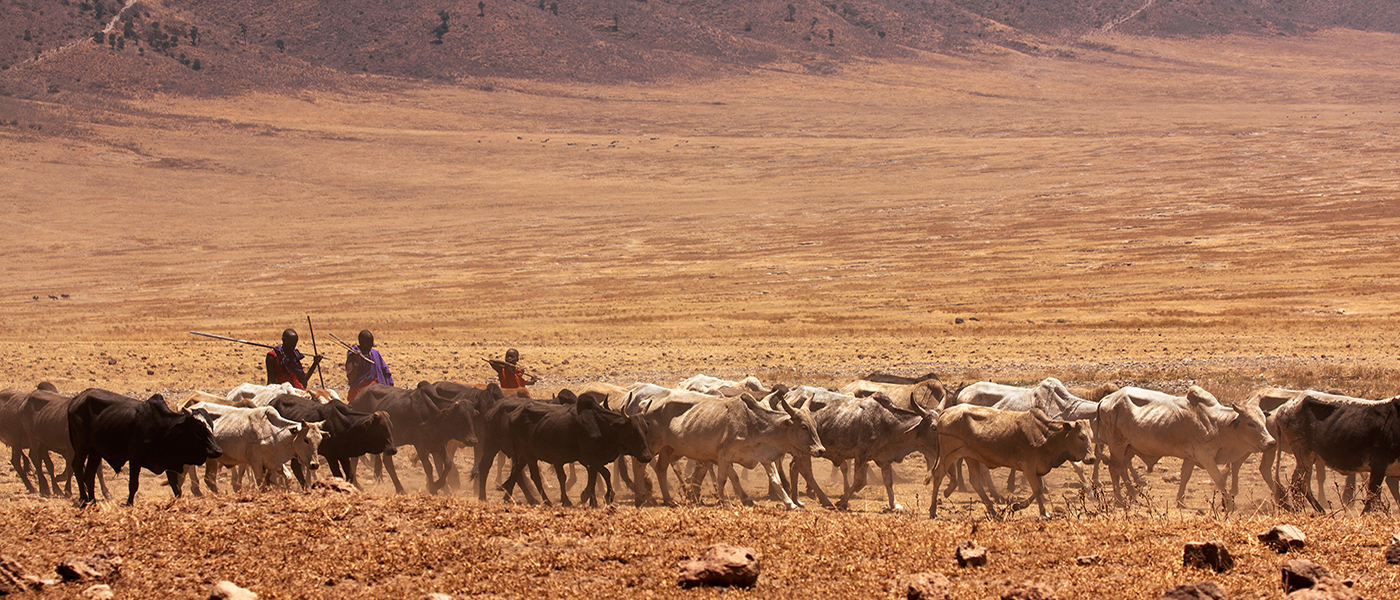
Anthrax
Uncovering the true scale of a neglected zoonotic disease
In sub-Saharan Africa, anthrax is a serious, often fatal, zoonotic disease that is chronically underreported. There is little data on the number of people and animals affected despite rural communities having dealt with the disease for generations. Now, a team of researchers, led by Dr Tiziana Lembo and Dr Taya Forde from the Institute of Biodiversity, Animal Health & Comparative Medicine, are working with Maasai communities in Tanzania to understand the impact of this disease with the aim of making it more visible to policymakers and the wider world.
Anthrax is an infection caused by the bacterium Bacillus anthracis. It forms highly resistant spores that live in the soil for long periods of time. The disease primarily affects herbivorous livestock and wildlife who ingest the spores when grazing on contaminated soil. Humans contract the disease when they come into contact with the spores through inhaling or ingesting them, or when the spores enter their skin, usually through a cut. In Africa, people most commonly contract the cutaneous form of anthrax through handling carcasses of livestock that have died from the disease. Symptoms range from treatable skin lesions to sepsis affecting the whole body. Anthrax can be treated with antibiotics unless it becomes systemic in which case it is only a short time before it turns fatal.
Anthrax has gained notoriety in the western world due to its spores being used as a weapon in bioterrorist attacks. Subsequently much of the research into anthrax is concerned with emergency preparedness in developed countries. Yet the reality is that the disease is far more prevalent in parts of Africa and Asia, and that it affects impoverished marginalised communities who have no political voice. As a result, it is classified as a neglected zoonotic disease.
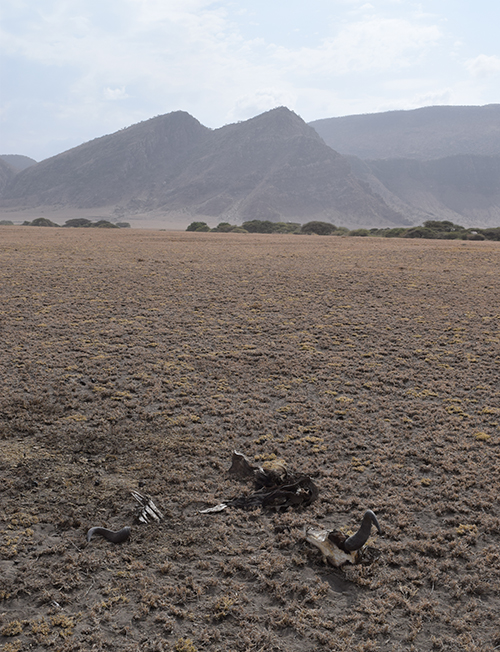
Underreporting of the disease
The underreporting of anthrax masks the severity of the issue and occurs for numerous reasons. The remoteness of the areas in which the disease tends to occur makes it difficult for people who contract anthrax to make it to a hospital, so few official statistics are gathered. Moreover, the communities affected by anthrax have often dealt with it for generations with the government unaware of the extent of the problem due to a widespread lack of data, something Dr Tiziana Lembo has witnessed in Tanzania:
"When we arrived, the communities were really excited that finally there was somebody who was actually interested in the disease. They tend to think that because it has been there forever there is probably nothing that can be done, so they have learned to live with it. That made it initially quite difficult for us to gather the numbers we needed to encourage action towards its control."
There were even fewer reported cases of anthrax in livestock due to the "very limited veterinary infrastructure in the area" with a greater focus on wildlife conservation rather than livestock.
Improving disease surveillance
Our scientists are now two years into a project working with government authorities and research institutions in Tanzania to improve disease surveillance and diagnostics. They are undertaking a number of initiatives working with communities in the Ngorongoro Conservation Area, to the south-east of Serengeti National Park in Tanzania.
Ascertaining the severity of the anthrax problem is difficult due to the lack of infrastructure in the area. So the team have implemented a grassroots-level information network that operates both as a means of collecting statistics on the disease and a way to increase awareness at all levels about its dangers. This was achieved by identifying community animal health workers, usually quite senior people in a village, who regularly meet with community leaders to discuss the disease. "They were incredibly enthusiastic from the beginning," says Dr Lembo, "demonstrating a deep interest in being involved, not just in reporting cases, but also in raising a lot of awareness at community level."
Field-friendly protocols were developed to help these community workers collect animal samples. These are easy-to-use collection kits that enable the workers to gather a sample, such as some animal hide or soil, from a carcass to identify whether the animal died from anthrax, including all the equipment to do so safely. As Dr Forde says: "we spent a lot of time developing these simple kits, trying to work out what would be easiest to collect and best in terms of diagnostic potential."
The samples are taken for molecular testing at the Kilimanjaro Clinical Research Institute. Already, the statistics being returned are starting to reveal the true scale of the problem.
"It's startling to us just how big of an issue it is," says Dr Lembo. "To give an example, when we started working in one area, the veterinary records had four to five cases a year reported officially. After a year and a half of working there, we've reached nearly 300 confirmed cases. That's just for one restricted area. So if we're to expand the surveillance across the entire area with those numbers, it's going to be in the thousands."
Capturing data on human anthrax is more challenging due to ethical considerations. However, clinical officers have been trained to collect samples and those working as part of the project team are now able to conduct in-depth interviews of suspect cases presenting to a hospital or even in households. The next stage to be implemented is 'verbal autopsy interviewing', whereby carers of someone who has died are interviewed to determine whether anthrax was the likely cause of death.
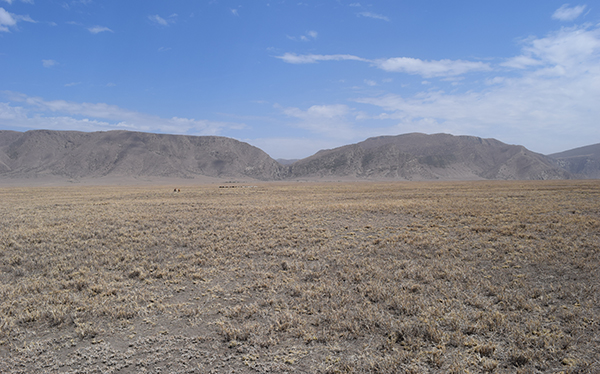
Ngorongoro conservation area, Tanzania
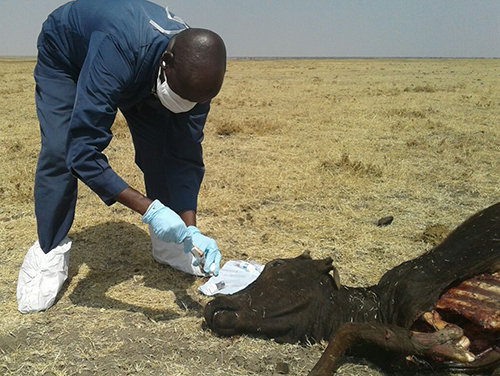
A community animal health worker collects a sample
Engaging with communities
Knowledge exchange workshops are another initiative our researchers have implemented. These workshops have allowed the researchers to engage with the community and various government-level stakeholders. The workshops are very much a reciprocal process. As well as informing the local community about anthrax and ways of preventing it, they enable the researchers to establish how the community cope with the disease, as Dr Forde explains: "They've allowed us to better understand the situation and to continuously have a dialogue of feedback and exchange as we've moved forward."
Talking to the clinical officers in the area has also revealed issues around dispensing antibiotics in remote areas. Though anthrax is treatable with penicillin, people who contract severe anthrax are often not given this at the first point of care in a rural area as it is assumed they should be treated in a hospital. However, the hospital can be several days walk away, meaning that tragically people often die on route. Dr Forde states: "These are completely unnecessary deaths so it's something that we're discussing with communities to ensure that treatment is initiated as soon as possible.”
Potential interventions
Through engaging with the communities, the team are also developing an understanding of what will and will not work in disease prevention. Awareness about the dangers of eating infected meat may seem like an obvious prevention measure but the reality is that these are poor communities that are reluctant to waste a precious meat resource. This is exacerbated by the fact that anthrax is an acute disease so animals appear to be healthy before they die, as Dr Lembo explains: "Unfortunately this is an area where people are not particularly scared of the disease, so if an animal dies suddenly, they will process the carcass and consume it."
Livestock vaccination campaigns are likely to be a more effective intervention, though the community animal health workers have warned that uptake of these campaigns may be limited. This is because livestock owners tend to be wary of government initiatives as there have been difficulties in the past when the government has sought to curb livestock numbers to protect wildlife. So livestock owners may fear a vaccination campaign is actually a strategy to kill their animals. As Dr Lembo points out: "There are a lot of issues with trust and awareness that would need to be considered with this type of intervention."
Participatory mapping, where local community members identify on maps the areas they consider at risk for anthrax, is another initiative that has proved enlightening for the team. This knowledge of the area has been built up by Maasai communities over generations and usually corroborates with the environmental characteristics, such as temperature, soil pH and elevation, needed for anthrax to thrive. Dr Lembo states: "I think it's interesting for two reasons because it allows us to identify areas of risk, but it also tells us how much the Maasai communities really know about this disease and about the areas that pose the greatest threats to their animals."
Despite the known risk, livestock owners claim they are often unable to avoid these areas as they are the only places they can water their animals during dry season - the time of the year when most cases of anthrax occur. But identifying these anthrax hotspots is still useful for both surveillance and vaccination campaigns:
"If resources are limited for surveillance, we can target the areas which are known to be at risk," says Dr Lembo. "It is also hugely helpful for timing and targeting of vaccination campaigns as we can provide the vaccines in advance of the dry risk periods, rather than waiting for cases. If livestock owners are telling us that they know this particular area is at risk but they really need to take one of their herds there for water, then this enables us to prioritise certain herds for vaccinations."
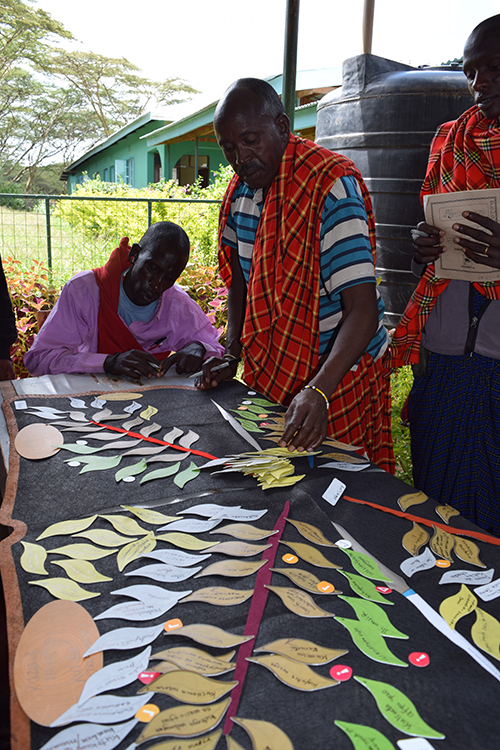
Knowledge exchange workshop
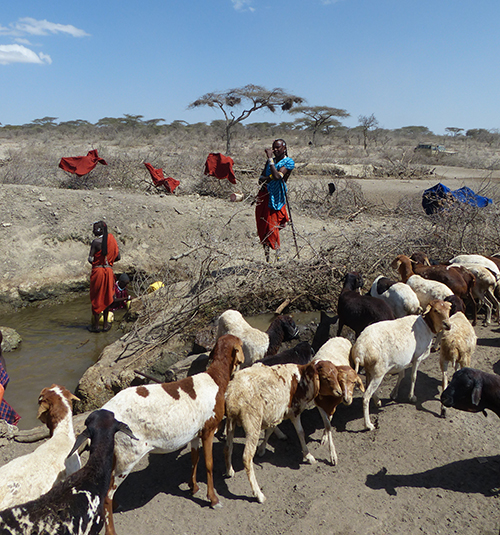
Livestock owners often have to pass through anthrax-infected areas to obtain water for their animals.
Impact of research
Our scientists’ research is already having a significant impact. Key findings have been shared with the Tanzanian government and are forming the basis of a national strategy document. This includes recommendations as to where and when to vaccinate livestock based on identification of risk areas and periods.
In addition, having demonstrated how much of a problem anthrax is in the area has contributed to the government recognising its importance and making it one of the priority zoonoses in Tanzania.
One Health at Glasgow
Underpinning all of our scientists' research on anthrax is a One Health approach. As anthrax is a disease that operates at the interface of the environment, humans and livestock, it is ideally placed for such an approach, as Dr Taya Forde says: "For me, this is one of the most easily defendable One Health situations in that there are major implications for the health of both people and animals in the same areas. People are becoming directly infected through handling their livestock, but there are also indirect repercussions in terms of food availability and the economic impact of losing a lot of livestock."
Moreover, a One Health approach is fundamental to fully understanding the context of anthrax, as Dr Lembo explains: "I also describe One Health as being able to work across disciplinary and sectoral boundaries. A problem like anthrax is a good example of the need to do that, because it is not just about understanding the biology of the pathogen, or how to do surveillance or get the best out of the data you have. It's also about understanding practices and behaviours and how we might work with communities to unravel the roots of these behaviours and possibly alter them to reduce the disease burden."
The University of Glasgow has a strong history of undertaking research on infectious diseases in Tanzania. This is something that Dr Taya Forde has found to be invaluable to this current anthrax research: "There's a large contingent of members of the Institute of Biodiversity, Animal Health & Comparative Medicine who have been working in Tanzania for a while, so for someone new coming in it's been incredibly helpful to be able to draw on that breadth of experience in regards to developing in-country connections and getting the appropriate research permits.”
Glasgow's strong focus on interdisciplinarity has also aided this One Health research: "The University is the ideal place to do work that sits at the interface of human and animal health because it is a very interdisciplinary environment where we can easily access people from various backgrounds to try and understand all the elements of the puzzle," sums up Dr Tiziana Lembo. "I've always worked in quite complex environments where you really need to have access to all disciplines and skills to be able to truly tackle a problem in its entirety."
Funding
For their work on anthrax, Dr Tiziana Lembo and Dr Taya Forde have received funding from the European Commission (Marie Curie Fellowship), the Biotechnology & Biological Sciences Research Council (BBSRC Future Leader Fellowship and Impact Accelerator Award), the Wellcome Trust through the Academy of Medical Sciences, the Bill & Melinda Gates Foundation, the Natural Sciences & Engineering Research Council of Canada, the Scottish Funding Council and the University of Glasgow Knowledge Exchange Fund.

